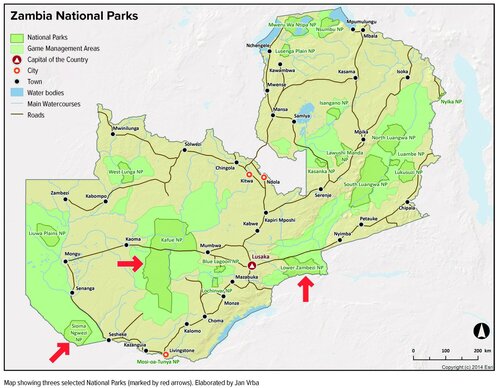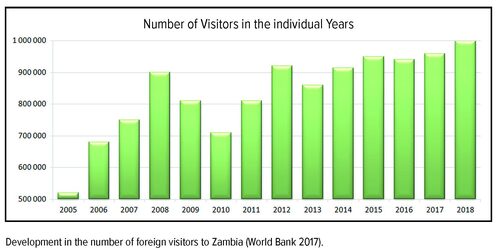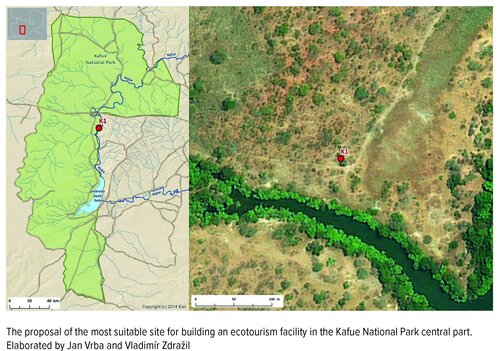The Journal is published by the Nature Conservation Agency of the Czech Republic in cooperation with the Cave Administration of the Czech Republic, the Krkonoše Mts. National Park Administration, the Bohemian Forest Mts. National Park Administration, the Podyjí National Park Administration and the The Bohemian Switzerland National Park Administration. It has been published since 1946.
cs / en
Nature Conservation 2021 — 10. 6. 2021 — International Nature Conservation — Print article in pdf
A Feasibility Study on:
„Improvement of Local Economic Prosperity and of Nature Conser- vation in Zambia supported by the Cz
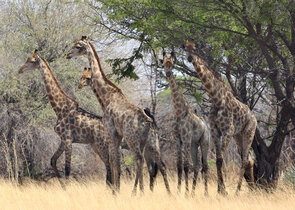
One of the significant preconditions for enhancing and improving nature conservation, biodiversity protection respectively in protected areas is ecotourism development, undoubtedly strengthening job opportunity/employment and economic prosperity in the countryside and at the same time also local community involvement in nature conservation (Eagles et al. 2002).
One of the significant preconditions for enhancing and improving nature conservation, biodiversity protection respectively in protected areas is ecotourism development, undoubtedly strengthening job opportunity/employment and economic prosperity in the countryside and at the same time also local community involvement in nature conservation (Eagles et al. 2002). Despite a lot of fluctuations, the number of foreign visitors has been increasing in recent decades and in 2018, it has reached for the first time one million. Thus, tourism has become one of the Zambian most rapidly growing economic sectors, providing directly or indirectly jobs to roughly 319,000 people, contributing 6.3% of the GDP, and income from foreign tourism representing 8.3% of Zambia´s total exports (ACT 2018).
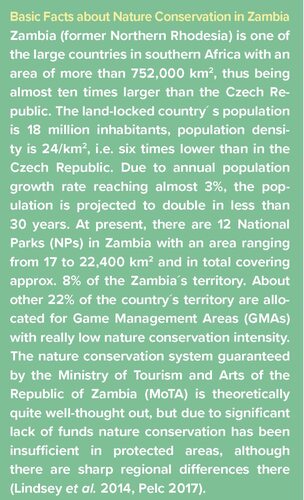 Nevertheless, a more detailed analysis shows that only about one quarter of foreign visitors to Zambia enjoy ecotourism in protected areas, in addition with sharp differences. More than 140,000 tourists visit the Victoria/Mosi-oa-Tunya Falls and about 23,000 of them enter the adjacent small Mosi oa Tunya National Park. The best-known South Luangwa National Park of the same size as Moravia, one of the historical lands in the Czech Republic, has recently hosted more than 40,000 visitors a year. The giant Kafue National Park covering 22,400 km2 is visited by approx. 13,000 tourists per year and the Lower Zambezi National Park is a destination of less than 10,000 visitors throughout the year. The other NPs display attendance in hundreds or a few thousands, sometimes only a few hundred: the latter category also includes the Sioma Ngwezu National Park. For comparison, in the Krkonoše/Giant Mts. National Park, the oldest NP in the Czech Republic, covering less than 400 km2, the annual visitor number is approx. 4 million persons. In the African context, the annual visitor number the famous giant Kruger National Park, being of 90% of the Kafue National Park´s size, amounts for more than 1.8 million. The above data and the comparison clearly confirm the enormous potential for changing the current state, namely by sustainable, nature-friendly tourism (cf. UKAid & World Bank 2011).
Nevertheless, a more detailed analysis shows that only about one quarter of foreign visitors to Zambia enjoy ecotourism in protected areas, in addition with sharp differences. More than 140,000 tourists visit the Victoria/Mosi-oa-Tunya Falls and about 23,000 of them enter the adjacent small Mosi oa Tunya National Park. The best-known South Luangwa National Park of the same size as Moravia, one of the historical lands in the Czech Republic, has recently hosted more than 40,000 visitors a year. The giant Kafue National Park covering 22,400 km2 is visited by approx. 13,000 tourists per year and the Lower Zambezi National Park is a destination of less than 10,000 visitors throughout the year. The other NPs display attendance in hundreds or a few thousands, sometimes only a few hundred: the latter category also includes the Sioma Ngwezu National Park. For comparison, in the Krkonoše/Giant Mts. National Park, the oldest NP in the Czech Republic, covering less than 400 km2, the annual visitor number is approx. 4 million persons. In the African context, the annual visitor number the famous giant Kruger National Park, being of 90% of the Kafue National Park´s size, amounts for more than 1.8 million. The above data and the comparison clearly confirm the enormous potential for changing the current state, namely by sustainable, nature-friendly tourism (cf. UKAid & World Bank 2011).
Briefly on the project´s history
The intention to support tourism infrastructure development for nature conservation and enhancing well-being of local communities in Zambia had appeared in the Czech Republic as soon as in 2016 (Pelc l.c.). Based on the outputs of a meeting between the MoTa and the Nature Conservation Agency of the Czech Republic (NCA CR), the Zambian partner officially asked by a letter expressing a strong interest for implementation of the project as a part of the Czech Republic´s Official Development Assistance (ODA): the request from the MoTA was also submitted to the Embassy of the Czech Republic in Zambia. The intention was assessed by the Czech ODA, preferring projects supporting agricultural development in the Zambian countryside, as lacking the acceptable parameters, and therefore unsuitable. After further repeated consultations, the Czech Development Agency (CDA) agreed to carry out a feasibility study credibly identifying priority areas and at the same time setting by expert opinions the investment and operational costs. In 2017, 2018 respectively, the Zambian partner asked both by a letter of the MoTA´s Secretary of State to the Embassy of the Czech Republic in Lusaka and consequently by official application asking for the feasibility study assessing three areas of interest for supporting development of a new ecotourism infrastructure in three National Parks, namely Kafue, Sioma Ngwezi and Lower Zambezi. In the middle of 2019, the Zambian initiative resulted in making a contract between the CDA and the NCA CR on implementation of the feasibility study. The study was elaborated by the NCA CR in cooperation with the Faculty of Environmental Sciences, the Czech University of Life Sciences Prague.
The respective feasibility study
The MoTA asked for carrying out the feasibility study which would determine suitable sites for building ecotourism facilities in the three NPs (see a map) proposed by the Zambian partner including tentative economic costs and based on a comprehensive comparative SWOT analysis also the undisputable priorities for possible implementation of the project.
A brief description of the three areas studied
The Kafue National Park
The Zambia´s largest NP is situated in the mostly flat landscape and is covered by miombo woodlands and at some sites, particularly in the northern part, by wetland plateaux. Within the area of the same size as Moravia, in total 20 year-round and some other seasonal ecotourism facilities have been established there. Moreover when taking into account the National Park´s size, there has been a much higher potential for further development. Of fauna, from a point of view of both ecotourism and nature conservation attractive populations of the African bush elephant (Loxodonta africana) consisting of 5,000–6,000 individuals, Hippopotamus (Hippopotamus amphibius), African buffalo (Syncerus caffer), Lion (Panthera leo), Leopard (Panthera pardus), Cheetah (Acinonyx jubatus), African wild dog (Lycaon pictus) and of the Spotted hyena (Crocuta crocuta) occur there. Among antelopes, the Kafue NP is inhabited by the Sable Antelope ((Hippotragus niger), Roan antelope (Hippotragus equinus), Common impala (Aepyceros melampus), Puku (Kobus vardonii), Lichtenstein's hartebeest (Alcelaphus lichtensteinii), blue wildebeest (Connochaetes taurinus) and the Lechwe (Kobus leche).

A panoramic view of the site on the confluence of the Kafue and Shishambe rivers
(the Kafue National Park) which appeared in the feasibility study the most suitable
for building an ecotourism facility.© František Pelc
As we have mentioned, the annual visitor number, i.e. 10,000–15,000, is relatively low. The details on the really large-size protected area are presented by Mkanda et al. (2018) and Plesník & Pelc (2018).
The Sioma Ngwezi National Park
The Zambia´s third largest NP (5,270 km2) is located in south-western part of the country on the Angolan and Namibian border and is characterized by miombo and acacia woodland and savanna vegetation on Kalahari Desert Sands, at some site also by open grassy and periodically flooded plains. In the past NP´s very fauna was almost fully exterminated by poachers two decades ago. At present improved active protection and location on large mammal migration/movement corridors among three countries have allowed at least partial recovery in fauna there. Similarly to the Kafue NP, also the Sioma Ngwezi National Park has become a part of the giant Kavango – Zambezi (KAZA) Transfrontier Conservation Area, covering the area comparable to France (cf. Pelc & Plesník 2016). From a point of view of ecotourism and nature conservation, the occurrence of a Southern giraffe (G. giraffa) autochtonous population has been important since the species does not live somewhere else in Zambia (a giraffe population in the South Luangwa belongs to other species, namely the Masai giraffe, G. tippelskirchii). In the past numerous elephant population was decimated by poachers: therefore, the current population size is of a few hundred. The proportion between elephant carcasses found and living specimens has been dramatically increasing, namely from 3% in 2008 to 85% in 2015. Moreover, the NP offers almost complete portfolio of other African charismatic megafauna including lions, African wild dogs, leopards and possibly cheetahs and some antelopes, but still in extremely low population densities. There is no permanent ecotourism facility in the NP, only along the Zambezi River about 30 km west from the National Park´s border, there are five camps and lodges.
The Lower Zambezi National Park
Also extensive National Park (4,094 km2) is situated along the bordering Zambezi River, reaching width of 0.5–2 km. The Zambezi River´s stretch in the NP is approx. 120 km long and is surrounded by a floodplain terrace of 2–15 km in width, a chain of hills exceeding 1,000 m a.s.l. and the Great Rift Valley slopes. Many wetlands and pools (in the NP, a part of the floodplain is some months flooded), diverse bush and savannas with landmarks, e.g. baobabs (Adansonia spp.) and the Northern Lala palm (Hyphaene ventricosa) contribute to the dramatic landscape scenery. A broad range of African fauna includes the African elephant (approx. 1,500–1,700 individuals), commonly occurring Hippopotamus, African buffalo, zebras, some antelope species, Lion (a small population of approx. 30–40 individuals), Leopard, Spotted hyena and rarely also the African wild dog, the latter having 3–5 packs there. While the Nile crocodile (Crocodylus niloticus) is common, the Black rhino (Diceros bicornis) was exterminated by poaching, the Cheetah has become extinct and the Giraffe is outside its distribution range there. Almost 400 bird species including the Southern carmine bee-eater (Merops nubicus nubicoides) of which up to 10,000 individuals nest in some colonies within the NP attract birdwatchers. On the NP´s territory, seven luxury ecotourism facilities have been step-by-step built, while ten facilities of various quality are located in the adjacent GMA. The National Park and its surroundings are threatened with possible mining. On the opposite river bank in Zimbabwe, there is the unique Mana Pools National Park where also endangered black rhinos have been surviving.
Comparative SWOT analysis and other feasibility study aspects
The aim of a feasibility study is clearly define a project and determine whether it can be implemented. The possibilities for the development are determined by the available opportunities and the unavoidable limits of resources; the market; the environment, the needs and requirements of the local community and political realities. As a part of the study, SWOT analysis was carried out aiming at strengths and opportunities, weaknesses and threats respectively. Strengths and weaknesses are the internal components (patterns) of the proposed project; opportunities and threats are external factors that may influence the outcome.
The detailed SWOT analysis of six sites in the above three National Parks followed international standards and was conducted independently by each expert. For elaborating the SWOT analysis comparing the individual sites and National Parks, in total 48 parameters were evaluated. Seventeen of them dealt with strengths (e.g. biodiversity, visually attractive landscape or possibilities for ecotourism activities), ten were related to weaknesses, such as seasonality in use, lack of ecotourism facility/equipment, insufficient involvement of local communities in ecotourism, seven were linked with opportunities (possibilities of involvement of local communities into the project, possible synergies with other bodies including NGOs, possible increase in nature conservation and management quality), while twelve represented threats (mining, poaching, negative impacts of ecotourism infrastructure building). Each indicator in the SWOT analysis has a weight of 1, 1.5 or 2 and a rating of 0–5. Each of five experts individually determined the weight and score for all defined parameters and sub-parameters. Weighted score (weight * score) then allowed to compare all the SWOT analysis outputs, using positive values for favourable parameters (strengths, possibilities) and negative values for unfavourable parameters. The detailed evaluation was conducted for all six sites selected by the MOTA, National Park Administrations staff respectively. A relatively easy access from the international airports in Lusaca and Livingstone was a primary criterion, namely up to a half-day car ride.
The model structure of an ecotourism facility of medium and lower class was also elaborated.
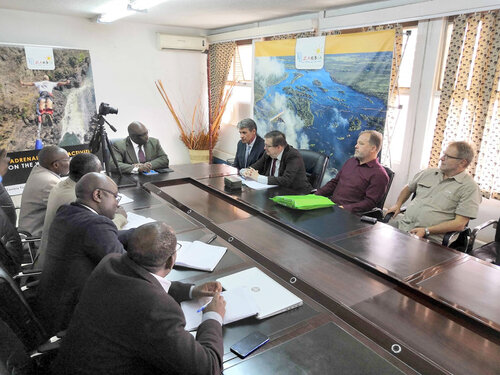
The MoTA´s representatives have been for a long time showing an interest in
implementing the NCA CR´s project. At the head of the table Secretary of
State Hon. Amos Mulapanga is sitting and the first person right to him is H.E.
Radek Rubeš, the Ambassador of the Czech Republic to Zambia. © Vladimir Zdražil
Outputs of the evaluation
The significantly most suitable parameters for the pilot project were found at the site located within the Kafue National Park on the confluence of the Kafue and Shishambe rivers. It reached 116 points in strengths, while the other sites 62–102 points, in weaknesses 28 (the other sites 35–37), in opportunities 64 (the other sites 50–55) and in threats 44 (the other sites 44–54). Strengths and opportunities were evaluated quite consistently by all experts, weaknesses for the Sioma Ngwezi site and threats for all sites display higher variability.
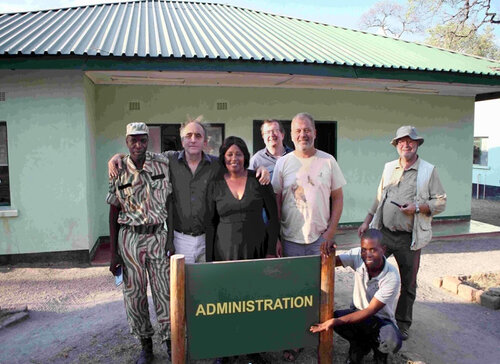
Together with Ms. Mirriam Namushi, Director of the Kafue National Park,
North Sector. © Vladimír Zdražil
By an expert estimation, establishing an eco-campsite would require an investment of CZK 3–4 million (EUR 118,000–158,000). Complementary initial costs (cars, computers, etc.) are estimated at CZK 2–3 million (EUR 78,000–118,000). Annual operational costs were also estimated (approx. CZK 350,000, i.e. EUR 13,800) as well as salaries/wages (CZK 500,000–900,000, i.e. EUR 19,700–36,000). In favour of the best evaluated site in the Kafue National Park, there is its accessibility (along a well-maintained unpaved road from the high-quality Mg asphalt backbone road, location just in the central part of the NP, proximity of the NP´s staff settlement), attractive and at the same time practical location on the confluence of two rivers and relatively high numbers of attractive wildlife there.
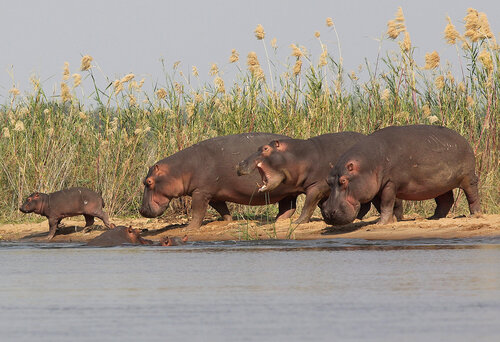
The Hippopotamus (Hippopotamus amphibius) population on the
Zambezi River in the Lower Zambezi National Park accounts
for some hundred individuals. © František Pelc
On the other side of the evaluation, there were sites from the Sioma Ngwezi National Park. The NP provides excellent landscape scenery of wilderness as well as recovering fragments of the native fauna populations. Moreover, their rather difficult accessibility along roads with deeper Kalahari Desert sands and absence of surface water (for water supply, there should be necessary to build water pumpers) at the sites studied decrease ranking and increase possible investment costs. Using lodges close to the adjacent Zambezi River or building new ones as a base for visitors and establishing a simple satellite camp just within the NP used for short-term stays in wilderness could help to solve the problem there.
From a broader view, the sites studied in all the targeted Zambian NPs are, although with various intensity, suitable for further ecotourism development and building related necessary facilities (Lodin et al. 2019).
What next?
The study outputs as well as a comprehensive background document providing the primary data were submitted to the Ministry of Tourism and Arts of the Republic of Zambia managing protected areas through the Embassy of the Czech Republic in Lusaca and consequently presented at and submitted to the Czech Development Agency. The study identified the priority site, suitable sites respectively for building sustainable ecotourism infrastructure and also provides an expert estimation of costs for building a model ecotourism facility with capacity of up to 30 visitors (in total, approx. CZK 6 million = EUR 237,000) and initial costs of operation (annually about CZK 300,000–400,000, i.e. EUR 11,800–15,800 a year) and salaries/wages (CZK 500,000–900,000, i.e. EUR 19,700–36,000 a year), with services provided by about ten local employees. Management of the ecotourism facility would be step-by-step handed over to the local community, supervised by the investor. All incomes will stay at the site, contrary to standard facilities run by foreign companies. At the same time, a suggested using food from the local products (vegetables, fruits, fish, etc.) should be highlighted as another issue of the development cooperation.
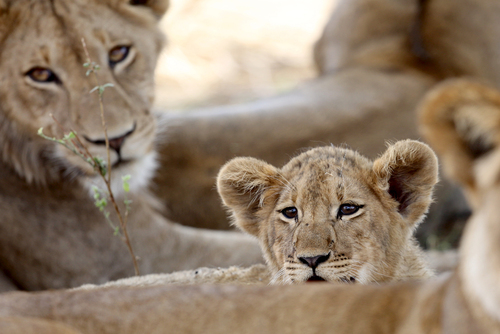
A curious cub in a lion pride, the Kafue National Park. © František Pelc
Where to find financial sources to implement the project? Using the Czech Republic´s ODA seems to be the most reasonable. In 2019, according to data available, CZK 20 million (EUR 788,000) were not spent from the Czech Republic´s ODA in Zambia so that they had to be redistributed by the United Nations acting in the region. Moreover, the above source could be possibly used after the necessary change in indicators, having been aiming only at agricultural (production) development in the Zambian countryside. Thus, indicators should be complemented by a possibility to support also non-productive aspects in rural development which are of the same importance as the former. The negotiations on this issue are carried out, inter alia, by the Ministry of Agriculture and the Ministry of the Environment of the Czech Republic. When speaking of that, it is necessary to mention that Zambia paradoxically displays overproduction of agricultural products, but due to the extremely low purchasing power of the population, most of them are exported to richer countries.

The Busanga Plains in the Kafue National Park harbour large herds of the
Lechwe (Kobus leche) attracting predators including lions and cheetahs.
© František Pelc
Currently, alternative completion of the project by exchange of students and staff between the Czech University of Life Sciences Prague and the University of Zambia in Lusaca (UNZA) had been under preparation: building a base for these activities in adjacent area to the proposed ecotourism facility has also been suggested. After examining suitability for re-introduction of the selected locally extinct species, e.g. the Black rhino or the Southern Giraffe, such measures could be implemented in cooperation with the Safari Park at Dvůr Králové nad Labem, the greatest breeder of African ungulates across Europe.

The African bush elephant (Loxodonta africana) population in the Sioma Ngwezi
National Park displays sharp fluctuations in numbers, partially caused by poaching,
partially by movement of animals to water source available within the migration
corridor among Zambia, Angola, Namibia and Botswana. The herd pictured
n the municipality of Nioma, consisting pf approx. 50 individuals, went to drink to
the Zambezi River outside the area. © František Pelc
If the formal successful modification of the conditions of the Czech Republic´s ODA happened, the MOTA would ask, based on the above feasibility study, for support in 2021. The activity should cover a pilot project involving also other local communities in the region where the evaluation of feasibility has been made in 2019 focusing on enhancing the capacities, skills and approaches also in the other sites having been studied. If this is successful, the further Czech Republic´s ODA then could target the other two NPs.
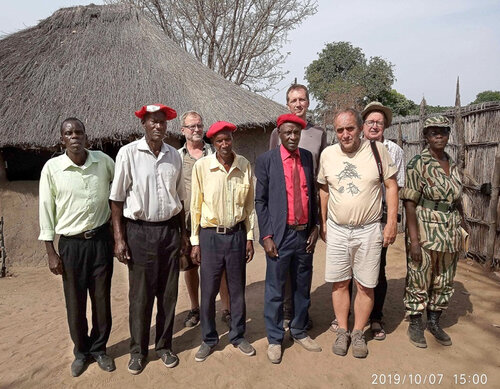
From a preparatory meeting with the Chancellor of the H.E. Royal Litunga/King
of Barotseland (in a red shirt) before the audience with the Litunga himself.
© Pavel Pešout
The project shows significant multiplication effects of the ODA´s outputs: it shall contribute, inter alia, to poverty alleviation, support to local communities, enhance nature conservation and biodiversity protection and also reduce migration of local people to urban areas or possibly to other regions or countries. Including the communication, education and research activities or possible wild animal reintroductions suggests another potential of the project´s development.
The project was peer-reviewed by Lídie Stellová (Stella Travel), an expert and a private entrepreneur in eco-
tourism in sub-Saharan Africa, and leading expert in research on and conservation of sub-Saharan biological diversity David Storch (Faculty of Science, Charles University Prague and Centre for Theoretical Study Prague, a joint research institute of Charles University and the Academy of Sciences of the Czech Republic).
Acknowledgment
The authors would like to express their sincere gratitude to the staff of the Embassy of the Czech Republic in Lusaca, particularly H.E. Radek Rubeš, the Ambassador to Zambia, for an excellent preparation of five meetings with key partners at the Ministry of Tourism and Arts of the Republic of Zambia and at the respective National Park Administrations.


